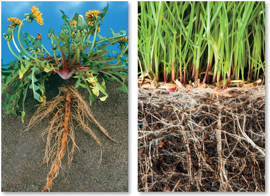23.2 Roots
 What are the main tissues in a mature root?
What are the main tissues in a mature root? What are the different functions of roots?
What are the different functions of roots?
root hair • cortex • endodermis • vascular cylinder • root cap • Casparian strip
Outline Before you read, use the headings of the lesson to make an outline about plant roots. As you read, fill in phrases after each heading that provide key information.
THINK ABOUT IT Can you guess how large a typical plant's root system is? Get ready for a surprise if you think that roots are small and insignificant. In a 1937 study of a single rye plant, botanist Howard Dittmer showed that the length of all the branches in the rye plant's root system was an astonishing 623 kilometers (387 miles). The surface area of these roots was more than 600 square meters—130 times greater than the combined areas of its stems and leaves!
Root Structure and Growth
 What are the main tissues in a mature root?
What are the main tissues in a mature root?
As soon as a seed begins to sprout, it puts out its first root to draw water and nutrients from the soil. Other roots soon branch out from this first root, adding length and surface area to the root system. Rapid cell growth pushes the tips of the growing roots into the soil. The new roots provide raw materials for the developing stems and leaves before they emerge from the soil.
Types of Root Systems The two main types of root systems are taproot systems and fibrous root systems, shown in Figure 23–5. Taproot systems are found mainly in dicots. Fibrous root systems are found mainly in monocots. Recall from Chapter 22 that monocots and dicots are two categories of flowering plants.
▸ Taproot System In some plants, the primary root grows long and thick and gives rise to smaller branch roots. The large primary root is called a taproot. Taproots of oak and hickory trees grow so long that they can reach water several meters down. Carrots, dandelions, and beets have short, thick taproots that store sugars and starches.
▸ Fibrous Root System In other plants, such as grasses, the system begins with one primary root. But it is soon replaced by many equally sized branch roots that grow separately from the base of the stem. These fibrous roots branch to such an extent that no single root grows larger than the rest. The extensive fibrous root systems produced by many plants help prevent topsoil from being washed away by heavy rain.

FIGURE 23–5 A Comparison of Two Root Systems Dandelions have a taproot system (left), while grasses have a fibrous root system (right).

Table of Contents
- Formulas and Equations
- Applying Formulas and Equations
- Mean, Median, and Mode
- Estimation
- Using Measurements in Calculations
- Effects of Measurement Errors
- Accuracy
- Precision
- Comparing Accuracy and Precision
- Significant Figures
- Calculating With Significant Figures
- Scientific Notation
- Calculating With Scientific Notation
- Dimensional Analysis
- Applying Dimensional Analysis




